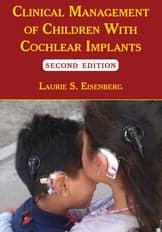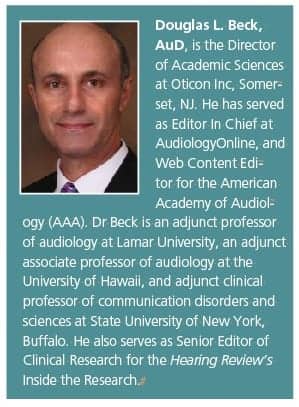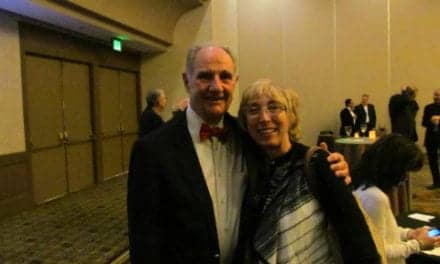Inside Clinical Research | November 2016 Hearing Review
Anyone who has worked in the area of cochlear implants has come across and been influenced by the work of audiologist Laurie S. Eisenberg, PhD. Dr Eisenberg is a Professor of Research Otolaryngology in the Tina and Rick Caruso Department of Otolaryngology-Head and Neck Surgery at the Keck School of Medicine of the University of Southern California. She is also a member of the Neuroscience Graduate Program at the University of Southern California.
Prior to entering doctoral studies in 1986, Dr Eisenberg spent 10 years at the House Ear Institute as an audiologist working on projects related to first-generation cochlear implants and the auditory brainstem implant. She returned to the House Ear Institute in 1996 as a scientist, investigating areas in pediatric hearing loss, speech perception, and auditory sensory devices. In 2013, she joined the faculty of the Keck School of Medicine of the University of Southern California, where she continues her research.
Her new textbook, Clinical Management of Children with Cochlear Implants (2nd Edition)1 has just been published by Plural Publishing, and it contains a wealth of information from some of the most knowledgeable people in the field on the subject of CIs. I thought it would be a good idea to catch up with Dr Eisenberg about her new book and some of the hottest topics in pediatric cochlear implants.
Beck: Hi Laurie. As always, it’s a pleasure to speak with you, particularly in light of the release of the second edition of Clinical Management of Children with Cochlear Implants. Congratulations!
Eisenberg: Thanks Doug. Great to speak with you, too. We’ve come a long way since working together at the House Ear Institute in the early-mid 1980s!
Beck: Absolutely. It’s hard to imagine the last time we spoke may have been when you released the first edition in 2009!

Eisenberg: Yes. Well, the field is moving in new directions and it seemed to be a good time for an update. Writing chapters and editing a book can be labor-intensive, but it is also a way to give back to the field. This time it was sort of a labor of love. Then again, as you can imagine, as soon as it was over I said louder and even more clearly “I will never do this again.”
Beck: I totally get it. The writing, asking, pleading, deadlines, pressures, permissions, friendship-dependent requests, and more really do add up. I recall the complete and utter frustration I experienced when I wrote my last book more than 20 years ago. A very dear friend/colleague/co-author was so incredibly late with his chapter submission that I actually had to write the entire chapter the day it was due, and then fax it to the publisher. It was at exactly that moment that I swore off writing textbooks!
Eisenberg: Well, it certainly became a nailbiter as the deadline approached, but I had an outstanding group of authors and they took the ball and ran with it. I am deeply indebted to them for sharing their expert knowledge with the readers.
Beck: For many people, and sometimes even for me, it’s hard to realize that over 30 years ago cochlear implants were considered an experimental treatment for deafness, and the political and social implications and ramifications were hotly debated and argued.
Eisenberg: Absolutely. We’ve come a very long way in a very short time. I addressed some of those issues in the first chapter of the book. You’re right, it was often volatile and contentious, but it was also an exciting time to be in the profession and to be surrounded by some of the brightest and most forward-looking people I’ve ever known.
Beck: I can recall protests at more than one cochlear implant (CI) presentation in the 1980s. Some parents, and some local and national associations, were upset as they thought those of us involved with cochlear implants were trying to change their children, or were trying to “fix” their children…and it seems to me in retrospect, we all understood their position, but we were trying to promote options and alternatives, not mandates.
Eisenberg: Yes, it was very controversial in the beginning and not just with the Deaf community. Quite a few researchers in the field were also antagonistic. Thankfully, we’re past most of that, primarily due to the remarkable outcomes documented on children’s development of oral communication. So, here we are in 2016, closing in on 2017, and we have many individualized options for children who are deaf and hard of hearing.
Perhaps in some respects, children born with hearing loss might be thought of as listening through a “black box” with respect to their auditory sensory devices. That is, we can supply children with hearing aids, cochlear implants, or whatever might be the most appropriate combination of technologies, yet despite our knowledge, expertise, and intentions, some children just don’t do as well as expected, and sometimes we’re at a loss to explain why. Don’t get me wrong, supplying salient auditory information to the developing brain of a very young child is indisputably important—but each child (and each ear) is different, and sometimes we can’t explain why one child succeeded and another didn’t.
Beck: We do know that, as a group, children with CIs are very successful, but as far as predicting individual success, that’s a significantly more difficult task, particularly because approximately 40% of children born with hearing loss have additional disabilities. Nonetheless, I do like the “black box” description, because in the final analysis, hearing aids and cochlear implants and arguably auditory brainstem implants and other hearing technologies only facilitate audition, which is (as you said) incredibly important, but it is not the only factor which determines who that child will become. Of course there are socio-economic issues, experiential and social issues, parenting and teacher issues, multiple physical issues (ie, comorbidities), environmental issues, and so much more. That is, the cochlear implant doesn’t exist in isolation from all other factors.
Eisenberg: And that’s why it remains essential to incorporate an evidence-based approach to clinical management that includes a thorough audiologic evaluation, ongoing speech and language evaluations, educational support, parent counseling, and much more.
The fact that a child is identified with severe-to-profound hearing loss doesn’t necessarily mean a cochlear implant is their best or only option. Of course, after all these decades and after tens of thousands of children who have received cochlear implants, we do know that the trend is to implant early, whether it be two implants (bilateral) or a CI in one ear and a hearing aid in the other ear (bimodal).
In the second chapter of the book, Winter and Rousso wrote an overview about clinical management, and they summarize many of the most important issues. They report one must be absolutely sure children have sensorineural hearing loss of sufficient degree, such that CIs offer a “better” alternative than hearing aids. They review the importance of a 3 to 6 month hearing aid trial, and address medical and other contraindications. For example, developmental delays and behavioral disorders must be considered, and we must be assured the child will have appropriate post-CI care, aural rehabilitation, and access to other important services to help assure success.
Beck: In essence, this is why we cannot have a “go to” solution. That is, we cannot simply say the “solution” for deafness is a cochlear implant. The individual child, their situation, needs, and the needs, desires, and preferences of their parents matter a great deal, too. And so the decision to proceed with a cochlear implant is rarely an easy decision.
Further, there are variations in the guidelines. For example, the Food and Drug Administration (FDA) says the minimum age to implant children is 12 months, yet many children are implanted between 9 and 12 months. Can you explain that?
Eisenberg: Well, the current FDA guidelines do say 12 months, but many surgeons will implant “off label” at younger ages. Today we are fortunate to identify hearing loss within a few weeks or months of birth (as is recommended by the JCIH), and when we initiate a trial with hearing aids by 2 or 3 months of age, we might conclude that a child is or is not benefitting from hearing aid amplification by age 7 to 9 months. So, in that situation, assuming an otherwise healthy child who is considered to be a good CI candidate, it becomes a decision for the CI team and the parents whether to implant under the age of 12 months.
In the new book, the current FDA guidelines are listed [p 72 by Aaron and colleagues), and they vary minimally with the three FDA-approved manufacturers. Further, if the child shows radiological evidence of cochlear ossification, the surgeon may elect to fast-track the cochlear implant while the cochlea is still viable.
Each situation is ideally addressed on its own merits. Of note, a study by Lovett, Vickers and Summerfield2 in 2015 evaluated 71 children fitted with hearing aids and CIs, and they found a child born with hearing loss of greater than 80 dB HL has a 4 times greater likelihood of doing better with a CI as opposed to a hearing aid, and so we’re seeing candidates in 2016 and 2017 who would not have been CI candidates 20 or 30 years ago.
Beck: Another important topic related to CIs is the auditory brainstem implant (ABI). For people not familiar with the ABI, in 1979 Drs House and Hitselberger placed an electrode directly on the cochlear nucleus of the brainstem of a patient with neurofibromatosis type II (NF2) following surgical removal of her tumor. Because the auditory nerve was sacrificed during tumor removal, a cochlear implant was contraindicated. The patient was able to perceive some sounds. Fast forward to 2016 and FDA trials are underway in young non-NF2 children unable to benefit from cochlear implants. Pretty amazing how quickly things change!
Eisenberg: Absolutely. The ABI may be a viable alternative for a select group of young children with cochlear nerve deficiency and/or malformed cochleas. We will know quite a bit more about this device in the not-too-distant future as the clinical trials progress. Readers can read more about the ABI in Chapter 23 by Fisher and her co-authors (also see the article, “Advances and Perspectives on the ABI,” by HR Associate Editor Christa Nuber in Hearing Review Online).3
On the other end of the spectrum, there are children with pure-tone thresholds who might be classified as having moderately severe sensorineural hearing loss, who could be eligible for cochlear implantation if they are not progressing with hearing aids. Specifically, they might have “aidable” hearing in the low frequencies, but demonstrate severe or profound hearing loss in the high frequencies, or they might have a unilateral hearing loss, and the only way for them to perceive those missing high frequencies in the worse ear might be a CI. Again, it’s not a “go to” approach, it’s just an available option if and when needed, based on how the individual child is progressing with regard to speech and language and other factors.
Beck: And so is it fair to say that, in 2016, some implant centers are more “progressive” with regard to implanting children who might not have met the candidacy criteria for a CI 5 to 10 years ago?
Eisenberg: Yes, this certainly is true, but the field has evolved rapidly and indications for candidacy continue to expand. Of course we cannot say yes, let’s implant, or no, let’s not, simply based on an audiogram [as discussed earlier], but some experienced teams are now exploring CIs in adults and children with unilateral or asymmetrical hearing loss to determine if interaural timing and interaural loudness differences, and to a greater extent binaural summation and binaural squelch, can be achieved with the CI. Although some people may find it surprising to think CIs are used to treat single-sided deafness, studies on this topic are emerging in the research literature.
Beck: I agree…and we’ve included in this article’s references section just five of the articles I’ve read on unilateral deafness and CIs and related matters, as some readers may want to look these up.4-8
Eisenberg: Thanks, Doug. I guess the bottom line with CIs is more or less the same as it is with other medical devices and their expanding indications for patients. Everything changes at a rapid pace, and it is important to keep up with the literature and professional presentations.
Beck: Laurie, you’ve been very generous with your time, and I know I have to let you go in a few moments…but would you please comment on CIs and Auditory Neuropathy Spectrum Disorder (ANSD)?
Eisenberg: Sure. As we’ve been saying, each child with hearing loss needs to be evaluated thoroughly on a battery of age-appropriate audiologic measures. When ANSD is first diagnosed, a hearing aid trial is almost always the first line of defense. We’re obligated to provide the child with the very best hearing aids—expertly fit—and our immediate task is to watch and evaluate their auditory, speech, and language skills. If they’re demonstrating progress, then it makes sense to continue with hearing aids. However, if the child is not making progress in developing auditory skills, it might be worthwhile to consider a CI. This becomes the domain of highly experienced clinicians, and these are not easy decisions to make. I refer readers to Chapter 22 [by Teagle et al] for more information on the topic.
Beck: OK, Laurie. It’s been great to spend a few moments with you. I am very impressed with the new book, and I give it my highest recommendation. I hope all of our doctoral programs will consider using this text as the standard CI text, and I wish you continued success!
Eisenberg: Thanks very much, Doug. Good to catch up with you, too, and thanks so much for the kind words!
References
-
Eisenberg LS. Clinical Management of Children With Cochlear Implants. 2nd Ed. San Diego: Plural Publishing:2016. Available at: https://www.pluralpublishing.com/publication_cmcci2e.htm
-
Lovett RE, Vickers DA, Summerfield AQ. Bilateral cochlear implantation for hearing-impaired children: criterion of candidacy derived from an observational study. Ear Hear. 2015;36(1):14-23. doi: 10.1097/AUD.0000000000000087.
-
Nuber CS. Advances and perspectives on the ABI. Hearing Review. 2015;22(4):30-33. Available at: https://hearingreview.com/2015/04/perspectives-miracle-abi
-
Baguley DM. Cochlear implants in single-sided deafness and tinnitus. Seminars in Hearing. 2010;31(4):410-413.
-
Buechner A, Brendel M, Lesinski-Schiedat A, Wenzel G, Frohne-Buechner C, Jaeger B, Lenarz T. Cochlear implantation in unilateral deaf subjects associated with ipsilateral tinnitus. Otol Neurotol. 2010; 31(9):1381-1385.
-
Kitterick PT, O’Donoghue GM, Edmondson-Jones M, Marshall A, Jeffs E, Craddock L, Riley A, Green K, O’Driscoll M, Jiang D, Nunn T, Saeed S, Aleksy W, Seeber BU. Comparison of the benefits of cochlear implantation versus contra-lateral routing of signal hearing aids in adult patients with single-sided deafness: study protocol for a prospective within-subject longitudinal trial. BMC Ear Nose Throat Disord. 2014; 14:7.
-
Tavora-Vieira D, Marino R, Acharya A, Rajan GP. The impact of cochlear implantation on speech understanding, subjective hearing performance, and tinnitus perception in patients with unilateral severe to profound hearing loss. Otol Neurotol. 2015;36:430-436.
-
van Zon A, Peters JP, Stegeman I, Smit AL, Grolman W. Cochlear implantation for patients with single-sided deafness or asymmetrical hearing loss: a systematic review of the evidence. Otol Neurotol. 2015;36:209-219
Correspondence to Dr Beck at: [email protected]
Original citation for this article: Beck DL. Inside Clinical Research: Cochlear Implants, ABIs, and More: An Interview with Laurie Eisenberg, PhD. Hearing Review. 2016;23(11):30.







